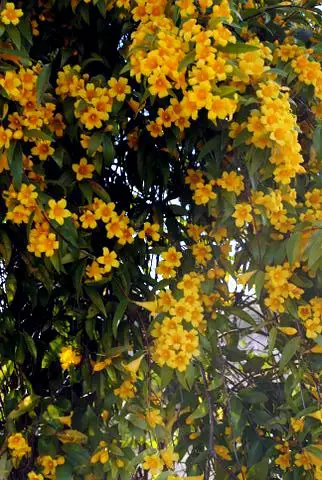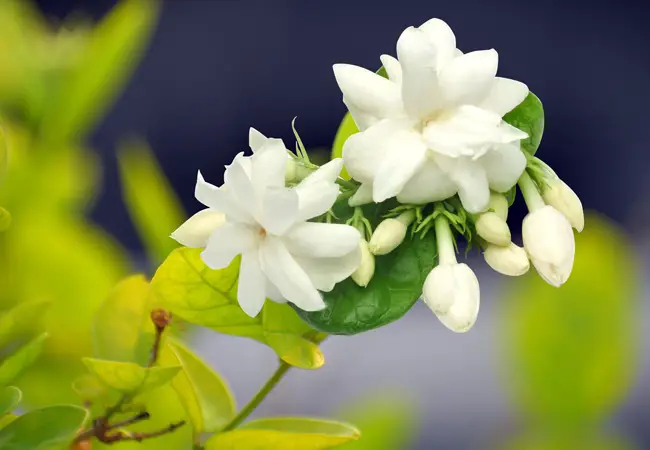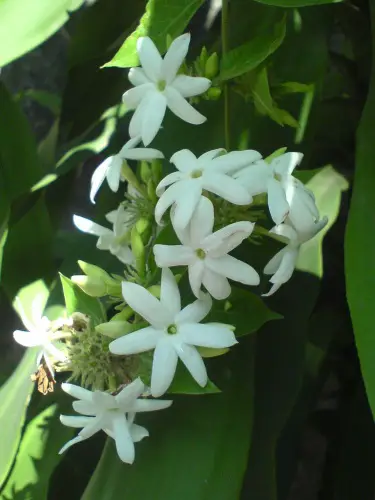Carolina Jasmine
When you are looking to brighten up your landscape or garden, you’ll find that Carolina Jasmine, also known as a Jessamine, is a prized find for several different reasons.
You may find yourself attracted to the color it can bring to your land, or you might be after something that the deer won’t feel free to nibble on! Take some time and learn about the Carolina jasmine and how well it can fit in your area.
Plant Description:
Once one has been pointed out to you, you will always be able to recognize Carolina jasmine. This is a beautiful evergreen vine that, under the right conditions, can grow up to twenty feet tall.
When kept in very bright conditions, it tends to stay rather compact, but when its roots are partially shaded, it can grow over trees, shrubs, fences, and trellises.
The rich green leaves are a beautiful counterpoint for the small clusters of tubular yellow flowers. This is a long-blooming plant, and you can enjoy the flowers from late winter to early spring, depending on where you are living. These flowers are particularly gorgeous and can add an impressive hint of color to your land.
Plant Location:
You’ll find that the Carolina jasmine is a native of the South. In the wild, it tends to grow along streams and in the lowlands and thickets. You can find it anywhere where there is a lot of shade, and though this is not a true water-loving plant, it does prefer damp areas.
They are most common near the coast, from the eastern part of Virginia, stretching down to Florida and west to Texas. You can also find it in Mexico. The further north you are of this general area, the harder this vine is to grow.
Culture Needs:
The Carolina Jasmine is a fairly hardy vine that can take a fair amount of abuse, but as you might imagine, a certain amount of attention needs to be paid to it. You’ll find that you can grow them from rootstock fairly easily or that you can acquire them from any nursery. You should plant them in a place where the roots are relatively well shaded, but it will do just fine if the leaves and vines see full or partial sunlight.
This can be something of an aggressive plant, and some prefer to keep them confined in pots for this very reason. While you should keep them damp (the soil they are on should not dry out between watering), take some care not to over-water them, as this can be a fundamental problem.
Ensure they are pruned after their winter-blooming, and if the plants become too top-heavy with seeds, it might be time to tie them to a trellis or a fence. The plant does quite well so long as the temperature does not dip below fifteen degrees Fahrenheit.
Landscape Usage:
Keep its dramatic coloration in mind when you see what the Carolina Jasmine can do for your garden. The Bright Yellow And Dark Green do quite well as an accent to most gardens, and you can choose to make the star of your landscape or just a lovely background detail.
Take some time and make sure that you think about how you want them to grow; they will reach for all the sunlight they can, and having a trellis or a shrub to train them up is essential for ensuring that they are not going to get out of hand.
Pros:
This is a beautiful plant, and in the right area, it is quite tough and very sturdy. If you live in an area that deer plague, you’ll find that these plants are quite resistant to the deer.
It is also relatively easy to care for, and it does not need all that much attention beyond pruning. It is fairly easy to find, and it is a great way to add a splash of riotous color to your garden. As among the first flowers to bloom, it is a beautiful sign of spring.
Cons:
Carolina jasmine is poisonous and should be avoided if you have small children. Depending on how sensitive you are, it can also cause problems with its sap, and handling it might mean that you need gloves on at all times.
It is also fairly aggressive and can choke out more delicate varieties unless you are careful. You will also find that the further north you are, the harder it will be growing.
The Carolina Jasmine vine has beautiful yellow flowers with a soft floral scent.
The Carolina jasmine vine has been discovered to originate from the South. Its abundance is evident in streams, lowlands, and thickets.
Jasmine also thrives well in damp areas. In particular, the vine is popular in the coastal areas of the eastern part of Virginia, in Florida, in Texas, and even in Mexico. Growing the vine plants would be difficult in the northernmost locations.
The Carolina Jasmine, also known as Jessamine, should be at the top of your list of beautiful plants to add to your landscape and garden.
You can easily recognize the Carolina Jasmine vine for its beautiful evergreen vine with a length that extends to almost twenty feet.
It usually grows independently in bright areas but can also be found around trees, fences, shrubs, and trellises if there is partial shading above its roots.
The richness of its green leaves perfectly matches the brightness of the Yellow Flowers. The time it takes for the vine plant to bloom is relatively long, lasting from late winter to early spring.
This blooming period may also vary in length according to the location. The beauty of these vine plants can enhance the vibrant image of your garden.
This may be a low-maintenance plant but would still require adequate attention and care. The usual sources of this vine are rootstock and nursery.
In looking for an area to plant the Jasmine, you should consider adequate shading for its roots. You must also ensure that the leaves or the vine will be exposed to full or partial sunlight. You may also consider putting them on pots.
Excessive watering should be avoided even though it should always be kept damp. After their winter-blooming, pruning should immediately take place.
Tying them to a trellis or a fence is the solution to excessive heaviness caused by heavy growth.
The benefits of planting a Carolina jasmine for landscape appeal are widely known. Its versatility is manifested in the fact that it can perfectly serve as background detail, and it can also be the Centerpiece Of A Garden.
Taking care of it also entails fewer hassles and inconveniences. Its blooming also implies the start of the spring season.
However, this Jasmine vine may not be a good choice for families with children who are still young because of its poisonous characteristic. Handling its sap may also be a bit inconvenient at times.
If you are in the northern areas, growing Carolina jasmine can be difficult. Its aggressive nature may also choke other gentler plants unless you take extreme care.
Arabian Jasmine
The Arabian Jasmine is also known as the Jasmine Sambac. It has beautiful foliage and fragrant flowers.
Arabian Jasmine is the most common name for Jasminum sambac, but there are plenty of other names for it as well.
You may have also heard of it as being referred to as mogra, Mallika, mallige, and kaliyan, but they are all the same popular plant!
Plant Description:
The Arabian jasmine is a scrambling bushy vine with shiny dark evergreen leaves and fragrant, small white flowers.
This plant will clamber and twine up almost anything, and they will use trellises or other plants to support their growth. One thing that makes this plant such a favorite in gardens worldwide is that the waxy white flowers will fade to a gorgeous soft pink as they age.
Plant Location:
It is thought that this plant originated in India, but it has been successfully cultivated in many, many other places. Arabian jasmine is a tropical plant, but it can even be grown in cooler climes. It may freeze to the ground in winter but can return from its roots when it gets warmer, especially if care is taken and the plant has mulch to keep it warm. It does very well in USDA Zones 9-11.
Culture Needs:
When you are looking to see what needs to happen so that you can start growing some Arabian jasmine of your very own, there are a few tips to keep in mind. They tend to prefer hot moist areas, and they need partial sun, with the full sun being ideal. The more sun they get, the more spectacularly they are going to flower.
When you water them, they should be very moist, but also keep in mind that their soil should not get soggy. A layer of mulch can ensure that your plant will grow well and that it does not get too soggy overall.
Similarly, when looking at fertilizer needs, these plants do very well with water-soluble, quick-release fertilizers and organic fertilizers like fish emulsion.
Pros:
In the first place, this is quite a gorgeous flowering shrub, one that anyone can be proud to have in their garden. It is quite tough, very hardy, and it will grow well in several climates.
You’ll also find that these flowers will release a strong and lovely fragrance and that they can add some lovely touches of color to your garden. When you are looking for something that will bring some beauty to your garden, this is the plant for you!
Cons:
Do keep in mind that the Arabian jasmine is primarily a warm-weather plant. While you can grow it in the north, you’ll find that recovery from the cold of the winter can mean that you are looking at a very late blooming the following year. This plant is also prone to mealybugs, aphids, and leaf spots.
If you are in a place where you are thinking of expanding your garden, this is definitely a plant that you want to consider. Stop and think about what these glossy dark leaves and waxy white blooms can give your garden.
Downy Jasmine – The Evergreen Vine
This lovely plant is a native of India, who prize it for perfume making and is used to make tea. In Florida, it tends to make beautiful tiny delicate white flowers that grow in a clustered fashion.
Often each bush will have five to six such clusters. The flowers themselves are star-shaped. Other jasmines are more fragrant than this type, but they can leave a delicate romantic aroma.
The Downy jasmine is an evergreen vine.
Gardeners prize it as it can be trained to remain in a shrub quality or as a spreading vine. Some have trained it to grow on walls, allowing for a beautiful spray of white flowers to come trailing down the wall when it is in bloom. As a tree, it can grow to 10 feet tall and be as wide as tall.
The leaves themselves are covered with a downy-like pubescence, which means that it has fine hairs making it appear more velvety than anything. The coloring of this pubescence is a mixture of green and gray.
The leaves of this beautiful plant are dark green, rounded at the base, and ovate in form.
Each leaf may be as long as 2″, and they grow as opposites on the stem.
It grows well in the hotter parts of the U.S., including Louisiana, California, Texas, and Florida. Luckily for those in colder climates, it can be grown as a houseplant since it takes well to being trained to remain small-sized.
Numerous gardeners have used this plant as ground cover. It will not push roots into the ground; thus, it will remain as a vine if you use it on a hill, but it covers the ground admirably well.
More often than not, people like it close to their front door due to the delicate scent that this plant puts out. It’s not overpowering as some other plants can be. As a ground cover, it’s more than workable.
Those who wish to grow their own Downy Jasmine will want to obtain woody stem cuttings.
The vine itself is basically drought tolerant, but the plant should never be allowed to dry out as it will not make the beautiful flowers, though it does not need copious amounts of water.
Fences allow this plant to grow well on them, as do trellises. Thus landscapers use this plant often.
Because it can be trimmed back, though, and therefore does not need a trellis or fence to climb, it’s a very versatile plant since it can be used as either a foundation or a climber.
If you prune it regularly, it will remain in shrub form.
You may find this plant called star jasmine due to its adorable star-shaped flowers that are not only dainty but considered very romantic, probably due to its feminine scent.
Also, I am told that Downy Jasmine pearl tea is supposed to be a wonderful tea.
Read also.




My jasmine is not blooming.
I bought a house with an iron fence covered in this vine. Vines are irrigated. Lateral shoots now invading boxwoods and whatnot alongside. The base of the fence and roots of the vine well shaded; top bushed out to nearly four feet in thickness. Have seen only a few blooms over the last several seasons.
It’s now July. Located outside Knoxville, TN. When should I do what to prompt these plants to blossom next spring?
Hello Nancy.
There is a term “stimulated growth” which refers to plants that are either over-fertilized or unbalanced in NPK or other plant nutrients. For example, excessive nitrogen in the soil when the Carolina jasmine should be flowering may trick the plant into continuing rapid shoot growth.
So, what you may want to do stop using any high nitrogen fertilizer and used one specifically for flowering plants. Better yet…add some well-rotted compost and/or worm castings to the base of the plant before the jasmine should begin flowering. These materials will improve the microbial structure and nutrient content of the soil.
Dear Sirs, I live in Malta and bought my Star Jasmine last October. It is growing in a large pot, up a trellis, on my balcony. In the early Spring, new leaves appeared, and about two months ago beautiful, fragrant white flowers appeared. Now the flowers are turning brown and dying. Could you please tell me what care I know have to give to my plant?? Many thanks for your help.
This sounds like the typical growth pattern of the star jasmine. In Central Florida, the vine blooms from early spring through to mid May. The flowers will brown drop, but the plant will continue to grow throughout the year.
The star jasmine is a wonderfully fragrant jasmine vine that blooms in Late April. The vine spreads fast along fences, arbor, and walls, covering them with hundreds of small white flowers. On a breezy day, you can smell the flowers as you pass by in a car or bicycle.
How deep do star jasmine roots go ? is it a surface rooter? Can it damage house foundations?
No, the roots will not damage your home’s foundation. Star jasmine roots extend about a foot into the ground here in Central Florida. It’s possible they won’t get that deep because of your frigid temperatures.
It is over 100 degrees daily and has been for some time in Texas near the Waco area. I just bought a quantity of the confederate jasmine and am wondering if I can plant them now with it as hot as it is? I am here daily to water and care for them if I can. Also, I plan to dig a hole twice the size of the container and put in miracle grow soil to start them.
Any info will be appreciated
To be safe I’d wait until it cools down a bit. The best time of day to transplant the jasmine into the ground is early in the evening. This allows the plant to adapt overnight before it reaches its hottest point. One more point. You don’t want to leave water on its leaves at sunset. Fungus and set in and cause plant problems.
The orange jessamine is one of my favorite jasmine plants. The aroma of its flowers is very similar to a flowering orange tree. I’ve had one for many years and have trimmed into a square, and tapered it at the bottom. It looks like a course hedge now.
The leaves are deep, dark green and it flowers several times a year here in Key West. The flowers have a scent to die for. They develop into clusters much like citrus and orange blossoms in springtime. Just lovely. I have given little attention to the care of this jasmine, other than trimming and it has done fine. It receives 4-5 hours of direct sunlight a day with equal parts of shade.